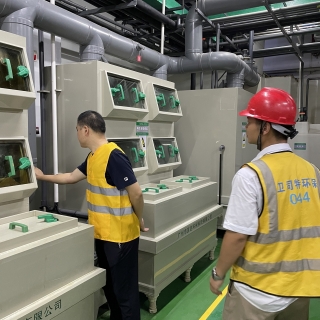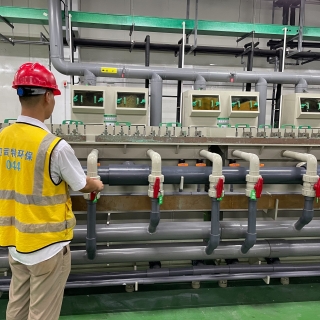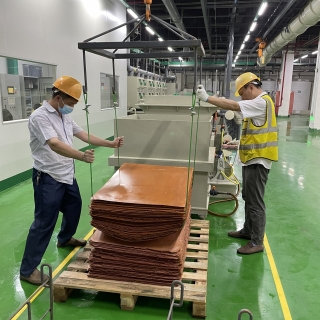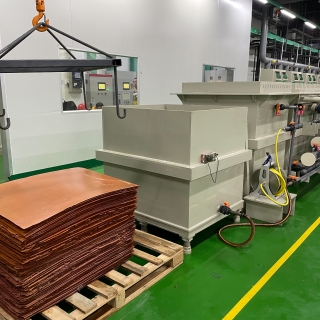Product Introduction
Acid-etching process is a common PCB manufacturing process for circuit formation, and copper chloride is normally the main chemical for the etching solution. Its principle is to utilize the oxidizing ability of Cu2+ ions, and etch the Cu metal on the copper clad laminate into the solution. During the etching reaction, the Cu2+ ions will transform into Cu+ ions, and exist as the CuCl2 formation, which does not possess the etching ability. Therefore, the solution should continuously add the oxidizing agent such as sodium chlorate, which can oxidize the Cu+ ions back to the Cu2+ ions, and maintain the activity of chemical.
When the copper concentration inside the solution is higher than 100 g/L, the etching rate will gradually slow down and losing its functionality owing to the saturation of copper, and it becomes the highly-concentrated Cu wastewater. The conventional way to recover the Cu metal is by adding sodium hydroxide, sulfuric acid, or sodium carbonate to permutate the Cu ions into solid formation, and transform it into Cu-related compound such as copper oxide, copper sulfate, or copper carbonate. However, such method requires huge amount of hydroxide, and the recovery rate of Cu metal is low. In addition, the high chloride ion contamination is inevitable, and the recovered Cu-related compound has risk of uncertain selling destination.
Based on the bottleneck of traditional method, Waste Recovery Technology develops the on-line electrowinning recovery system, and realizes the possibility to re-use the wastewater back to the production line.
The acid-etching electrowinning recovery system adopts the membrane electrolysis principle. With the ion-selective membrane, the copper chloride wastewater is divided into the anode and cathode compartment. The Cu electrodeposition reaction is occurred in the cathode, and Cu metal with >99% purity is deposited. In the anode compartment, the chloride ion in the wastewater is electrolyzed, and chloride gas is generated. The Cl2 gas is conveyed to a customized adsorption chamber, and the chloride gas is mixed with the copper chloride solution. The Cl2 gas can oxidize the inactive Cu+ ions into Cu2+ ions, and enhance the solution etching activity. In the meantime, it successfully reduces the usage of oxidizing agent. For the residual Cl2 gas, it will pass through our customized iron adsorption system, and transforms into the FeCl3 solution, which can be further employed as the coagulation chemical for the wastewater treatment plant.
Waste Recovery Technology’s on-line electrowinning system has following advantages:
- Can recover the Cu ions in the copper chloride wastewater into metallic copper, not traditional Cu-related compound.
- Can re-use the solution back to the production line, and reduce the cost of buying oxidizing agent or HCl chemical.
- Waste Recovery Technology can offer stable etching solution for the production line.
- Compared to adding new etching chemical, the etching rate of our solution is more stable since the floatation of Cu concentration is lower.
- No need to add sodium hydroxide, which greatly reduce the cost.




